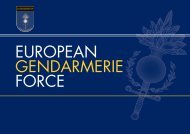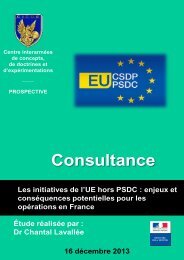Conference
science-research-bulletin-2013-conference
science-research-bulletin-2013-conference
Create successful ePaper yourself
Turn your PDF publications into a flip-book with our unique Google optimized e-Paper software.
EUROPEAN POLICE SCIENCE AND RESEARCH BULLETIN<br />
SPECIAL CONFERENCE EDITION<br />
policing is that informal control mechanisms,<br />
and not the police, guarantee order in the<br />
community. If community cohesion is weak, the<br />
community as such cannot implement control<br />
mechanisms. Therefore, if we want to study the<br />
possibility of implementing community policing<br />
seriously, some attention must also be devoted<br />
to strengthening community cohesion. This is<br />
above all a task for local authorities.<br />
Conditions for efficient policing in the Roma<br />
communities are multifaceted. First, the state<br />
is responsible for the legal protection of Roma<br />
communities. Under this protection, the basic<br />
conditions for the preservation of the particular<br />
ethnic and cultural characteristics of Europe’s<br />
largest minority on the one hand, and sufficient<br />
integration into society on the other, are created.<br />
Second, the local level involvement of Roma<br />
municipality councillors in decision-making<br />
processes provides a good connection between<br />
a relatively closed community and the larger<br />
community in which they live. If we include<br />
projects for the empowerment of the Roma<br />
community carried out by local authorities,<br />
we are getting closer to success. All this is a<br />
necessary precondition for the training of police<br />
officers to work in a multicultural environment<br />
to be effective. As we see in the case of Slovenia<br />
(Strobl et al. 2013) and the Municipality of<br />
Lendava (Lobnikar et al. 2013), such training<br />
gives results. This compels us to echo the opinion<br />
of Tanja Fajon (2011:114) that in all of this can<br />
be found an example for Europe — an example<br />
of good cooperation and co-habitation of Roma<br />
and non-Roma communities.<br />
REFERENCES<br />
Banutai, E., Strobl, S., Haberfeld, M.R. & Duque, S. (2011). Sodelovanje policistov in romske skupnosti.<br />
“Cooperation between the police and Roma community”. In T. Pavšič Mrevlje & I. Areh (Eds.), Zbornik<br />
povzetkov, 12. slovenski dnevi varstvoslovja. P. 70. Ljubljana: Fakulteta za varnostne vede UM.<br />
Brearley, M. (2001). The Persecution of Gypsies in Europe. American Behavior Scientist. Vol. 45. No 4.<br />
Pp. 588-599. http://abs.sagepub.com/content/45/4/588.refs.html<br />
Erjavec, K., Hrvatin, S. B. & Kelbl, B. (2000). Mi o Romih: Diskriminatorski diskurz v medijih v Sloveniji.<br />
“We About the Roma: Discriminatory discourse in the media in Slovenia.” Ljubljana: Open Society<br />
Institute.<br />
Fajon, T. (2011). Forgotten by Time. In: Flašikova-Benova, M.; Swoboda, H. & Wiersma, J. M. (Eds.)<br />
Roma: A European Minority. EU. Progressive Alliance of socialists and Democrats in European<br />
Parliament.<br />
Djurić, R. & Muc, J. H. (2010). Zgodovina romske književnosti. “The history of Roma literature” Murska<br />
Sobota: Zveza Romov Slovenije.<br />
Horvat Muc, J. (2011). Romski jezik — osnova za razumevanje zgodovine in kulture Romov. “Roma<br />
language — basis for understanding the history and culture of the Roma people” Murska Sobota:<br />
Zveza Romov Slovenije.<br />
Lobnikar, B. & Meško, G. (2010). Responses of police and local authorities to security issues in<br />
Ljubljana, The Capital of Slovenia. In M. Cools et al. (Eds.), Police, policing, policy and the city in<br />
Europe. Pp.175–195. The Hague: Eleven International Publishing.<br />
71





